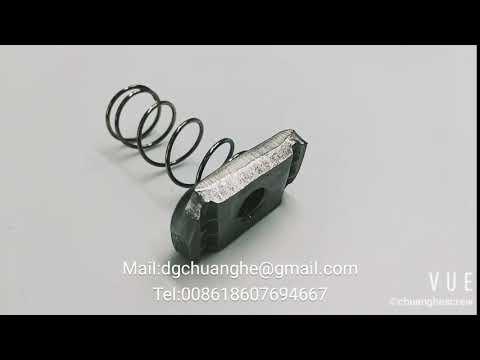We are grateful that you have been paying such close attention to the program guide. In this lesson, we will study the operation of mechanical springs, which will cover topics such as the various kinds of springs and the applications that can be found for each type of spring. Additionally, we will discuss the various applications that can be found for each type of spring. To get started, we need to have a better understanding of elasticity, which is the property of a material to return to its original shape after being deformed as a result of the application of a custom nuts supplier and then to change shape again in response to the removal of that force. Elasticity can be defined as the property of a material to return to its original shape after being deformed as a result of the application of a force and then to change shape again in response to the removal of that forceThe ability of a material to return to its original shape after being deformed as a result of the application of a china nuts manufacturer is an example of the property known as elasticity. Elasticity can be defined as the ability of a material to return to its original shape.
#Spring nut manufacturing industry
Elastomeric properties can be found in a wide variety of different things; for instance, when stretched, sponges and even metal beams and bridges deform much less than they would if they were not elastic. Other examples of elastomeric properties include:A minuscule change occurs in a thing whenever that thing goes through the process of being stressed by the application of force. Every object will be changed as a result of applying this transformation. When the external custom nuts supplier is removed, and only then, the material will revert back to its prior shape. Because it has now assumed its initial form, it is appropriate to speak of the material as being elastic now that it has reached this stage. In the process of the sponge being compressed, we can see how it is being squeezed by the plunger as it is being compressed; however, once the plunger is removed, the sponge will return to its original shape, as if nothing had happened at a more advanced technical level. Case in pointThe behavior of most elastic materials is consistent with Hooks' Law; however, the amount of china nuts manufacturer required to cause deformation is proportional to the amount of change in shape or extension of the material that is caused by the force.
OpenBuilds Tee Nuts Comparison (Drop In VS Spring Loaded VS Regular)
When a material possesses elasticity, the diagram will typically show that property in a linear relationship with plastic deformation. Case in point: Case in point:Take, for example:Take, for example:Having said that, this relationship is nonlinear, and the deformation that it causes is irreversible. Moreover, the relationship causes the deformation in the first place. It is possible to demonstrate the relationship that exists between stress and strain by applying Hooks' law to a circumstance that takes place in three dimensions.
Strain, which is defined as an increase in length relative to its starting point, can be thought of as being in a linear relationship with stress. This is because strain is defined as an increase in length. Stress is quantified by determining the total amount of force that is exerted over a particular area. This results in the introduction of the variable known as Young's modulus, which is represented by the constant E. This is a direct consequence of what has just been stated. By referring to this fundamental physical principle, one is able to gain an understanding of the elastic behavior that is depicted by the stress-strain diagram. It is possible for it to be quite distinguishable from the myriad of other materials that are composed of metals due to the composition of its constituent elements. In the beginning, atoms are motionless while they are contained within the atomic lattice that they are a part of. This is a state in which there is a comparatively low amount of energy present.
The addition of a nuts manufacturer to the system results in the system gaining energy, and the application of forces is what causes the system to deform as a result of the forces themselves. Once the force that was acting on the lattice has been removed, it will revert to the state in which it initially had a low amount of energy. This state is known as the "low energy state."As a direct consequence of this, there are instances in which we are in a position to make use of it in an unbroken fashion for an appreciable amount of time. If an excessive amount of force is applied, the spring will become heated, and the bonds between the atoms in the lattice will break. This can only happen if the force is applied in proportion to the spring's length. This is only possible if the force that is applied is in direct proportion to the length of the spring. As a direct consequence of this action, the thief will undergo a complete and irreversible metamorphosis into a plastic state.
Other kinds of polymers acquire their elastic properties when they are subjected to an excessive amount of force. This is because the chain of the polymer is stretched out during the process of subjecting the polymer to the force. However, if an excessive amount of force is applied, the chain that makes up the polymer will separate into its component parts once more. The quality of elasticity can be observed in action in the manner in which certain things, spring manufacturer such as springs, carry out their operations. The fact that their primary function is to change shape in response to the application of a force distinguishes these springs from other kinds of springs. Because of this, steel beams and sponges both have the potential to exhibit elastic behavior; however, this is not the primary function of either of these materials. Sponge and steel beams are both used for other things. Now that we've gotten that out of the way, let's take a look at a few of the most common types of springs and the first stop springs that are associated with each of those springs.
These springs have the ability to support additional weight in addition to being stretched out further. The subsequent indicator of weight that may be utilized is the compression spring. They are brought closer together, which is what we mean when we say that they have been compressed. They spend the vast majority of their time performing tasks that are associated with the suspension systems of automobiles and mattresses. The constant four springs are made from metal wires that are wound very tightly, and as the springs unwind, the energy that they have been storing is gradually released. Because of their ability to open and close hinged objects, torsion springs are frequently used in the mechanisms of timepieces and clocks. This is due to the fact that these springs can rotate 360 degrees. The springs that are typically found in rat traps can serve a variety of purposes, some of which are more important than others in the overall design of the trap. They have the ability to both draw power from energy stars and release it by using damping springs, which gives them the ability to do both things at the same time.


